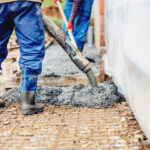How to Get Started in Masonry
Masonry is a craft that has been around for thousands of years, transcending different cultures. It is an art that is extremely rewarding to practice because the final product is a perfect replica of the original. The craftsmanship is also required for industrial revolution factories and the housing stock of major cities. For more information, visit this website at https://masonrycharleston.com/.

Lay the foundation. Then you will lay the first course of masonry. A mortar joint of about 1/4 to 3/4 inches is required for this first course of masonry. This is necessary to compensate for the irregularities of the footing or foundation. You must be sure to use a full bed joint between the foundation, footing, and slab. Make sure that you check for levelness before beginning. Otherwise, you may encounter problems when finishing the foundation.
Masonry has a high strength of compression. In addition to being resistant to compression, masonry can also withstand extreme lateral loads and gravity. This is what makes masonry such an excellent choice for foundation walls. But there are a few limitations to masonry construction. In general, it isn’t a good choice for large buildings. If you’re building a house, you’ll need to consider whether masonry is the right choice for your home or not.
The choice of masonry materials has long been based on the geological formations of a particular region. Some countries, for instance, used limestone, sandstone, alabaster, granite, basalt, and porphyry for their temples. In contrast, western Asia lacked stone outcroppings but had clay deposits. Therefore, the Assyrian and Persian empires used sun-dried bricks.
Before installing masonry, make sure you follow the proper techniques to finish the job correctly. For example, mortar should be thumbprint hard on each side, and it should extend to the bedding surfaces of hollow units. When applying mortar to solid units, make sure to use a sled runner. Likewise, mortar should be applied to both sides of the block to ensure a tight seal. When grouting, ensure that the mortar joints are 10 mm thick horizontally and vertically.
Because masonry materials are heavy, they must be supported on solid ground. A concrete slab on top of crushed stone acts as a footing, distributing weight over a larger surface area. It also helps the masonry above to move slightly. This is important as masonry expands and contracts with temperature changes. Without proper footings, masonry can crack or fall in an earthquake. So, be sure to check the soil conditions before choosing a particular type of masonry.
While brick masonry can be very economical and does not require highly skilled labor, there are some disadvantages to this construction technique. For one, bricks are much less durable than stone, and brick joints are thinner. Furthermore, bricks are limited in size and color compared to stone. The finished product also requires plasterwork, which adds to the construction costs. And last but not least, bricks are not as resistant to high-tensile load as stone, so they are not suitable for buildings that have high foot traffic.
The type of mortar used in masonry is important when using it. Type M mortar is used in areas where there is significant load bearing on the structure. Type K mortar is weaker and may fail prematurely. For this reason, type K mortar is no longer included in ASTM C 270 standards. Nevertheless, it is still used in some pre-historic preservation projects. You need to know that mortar is not a perfect material before laying it on the job.
Concrete blocks are another type of masonry construction. Known as breezeblocks, concrete blocks are often larger than regular bricks and are faster to lay. They have lower water absorption rates than brick and are commonly used in industrial buildings. They are also commonly decorated with stucco surfaces. Moreover, they can contribute to green building certification. However, they are not as durable as bricks. Nevertheless, concrete blocks are a great option when it comes to building a wall.
Energy Efficient Mini Split AC Systems
Mini-splits are the most energy-efficient type of air conditioning system on the market. They eliminate the need for ductwork, which accounts for as much as 30% of the total energy used by an air-conditioning system. This amount is even higher in unconditioned spaces. With a SEER of twenty, the system would only use half the amount of electricity it would in the summer.
Mini-split systems operate without ducts, which can be an obstacle in the installation of traditional HVAC units. Because mini-splits are located outdoors, they are quiet and require no ducts. Unlike their larger cousins, mini-splits can cool multiple rooms at once. These systems are great for apartments and homes that have a large number of living spaces. Mini-splits can be installed almost anywhere and are easier to install than conventional systems.
Mini-splits also save money. They are energy-efficient and are capable of zoning. Some models can have as many as four indoor air handling units that are connected to a single outdoor unit. The number of indoor air handling units you choose depends on the building’s cooling needs, insulation, and air sealing. Since each mini-split unit is thermostat-controlled, you only need to set it to condition occupied spaces.
If you plan to purchase a new mini-split HVAC system, you’ll have to choose a qualified company to install it. The installation of HVAC equipment is extremely technical, so it’s important to hire a licensed technician to install it properly. Without proper installation, your mini-split won’t perform as efficiently as you want it to. Besides, a qualified company will know how to install mini-splits correctly and provide a warranty.
Mini-split air conditioning units are an excellent choice for people who live in buildings without basements. These units are quiet, discrete, and can help reduce your air conditioning bills significantly. And when it comes to comfort, these systems can heat or cool your home in winter. It’s worth mentioning that indoor mini-split units can also be used for heating purposes. You’ll be surprised at how much more comfortable your home is after a mini-split air conditioning system has been installed.
Before choosing a mini-split system, make sure you understand its cooling and heating capacities. The heating and cooling capacities of these systems vary significantly. In addition, it’s important to remember that the mini-split unit you choose is sized for the room you’ll be cooling or heating. A room that’s heavily shaded will require a lower cooling BTU than a room with a lot of sunlight. You can also increase the cooling capacity by adding 600 BTUs per person.
Advanced mini-splits use inverter-driven compressors and advanced control algorithms to optimize the efficiency of your home. These models can save 30% or more on energy bills and boast efficiency ratings of over 28 SEER. You can also choose a remote control for your mini-split. If you aren’t comfortable with your mini-split’s controls, you can always use the Flair Puck instead. The Flair customer support is excellent and you’ll be glad you chose this device over the Ambi.
If you’re looking for a more permanent solution for your home air conditioning needs, mini-splits may be the right choice. Mini-split systems are versatile and highly customizable and allow you to customize the temperature of individual spaces. One condenser serves up to five zones, each with its own thermostat. This means that you can heat or cool a specific room or area only when it’s occupied. And because mini-splits are small and can be installed in any pre-existing space, you can even use them in tiny homes without ductwork.
Another important feature of mini-splits is that they can also function as heat pumps. The reversed circuit allows the coolant from the outdoor unit to condense in the indoor air handler. This process then pumps heat into the building. Heat pumps are more energy-efficient than traditional heating and cooling systems, and certified heat pumps can use as much as 60% less energy. Mini-splits offer more flexibility and energy-efficiency than their electric counterparts.
Mini-splits are an excellent option for homeowners looking for flexible heating and cooling. Mini-split HVAC systems are a great option for homes without ductwork or central heating. In addition to flexibility, ductless mini-splits can be installed in rooms that were not previously served by a central heating and cooling system. This flexible system is also perfect for older homes without ductwork. This type of HVAC system is highly efficient and is an excellent choice for many homes.




